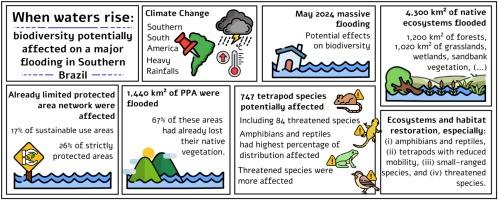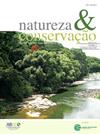当水位上升:生物多样性可能会影响巴西南部的一场大洪水
IF 3.5
2区 环境科学与生态学
Q1 BIODIVERSITY CONSERVATION
引用次数: 0
摘要
由于全球气候变化,预计南美洲南部将经历更多的强降雨。这些极端事件应该更加普遍,并对人类福祉和生物多样性产生负面影响。本文研究了2024年5月特大洪水对生物多样性的影响。我们发现,4300平方公里的原生生态系统被淹没,其中包括1200平方公里的森林和1020平方公里的草原。沙质土壤上的水生生态系统、湿地和沿海植被也受到影响。洪水影响了825平方公里的保护区(PA)网络,影响了17%的指定可持续利用区域和26%的严格保护区。同样,1440平方公里的永久保护区(PPAs)被淹没,其中67%已经缺乏原生植被。洪水可能影响747种四足动物,包括84种濒危物种,其中两栖动物和爬行动物的分布受影响的比例最高。受威胁的物种受到洪水的影响不成比例,尤其是两栖动物、爬行动物和哺乳动物。因此,在快速变化的世界中,恢复工作,特别是保护区和保护区的恢复工作,对于保护生态系统和人类社区至关重要。流动性低的四足动物、小范围物种和受威胁物种也应优先考虑。本文章由计算机程序翻译,如有差异,请以英文原文为准。

When waters rise: Biodiversity potentially affected on a major flooding in Southern Brazil
Southern South America is projected to experience increased heavy rainfall due to global climate change. These extremes events should be more common and affect negatively both human well-being and biodiversity. Here, we studied the effects of the massive flooding in May 2024 on biodiversity. We showed that 4,300 km2 of native ecosystems were inundated, including 1,200 km2 of forests and 1,020 km2 of grasslands. Aquatic ecosystems, wetlands, and costal vegetation on sandy soils were also affected. Flooding affected 825 km2 of an insufficiently Protected Area (PA) network, impacting 17% of areas designated for sustainable use and 26% of strictly PAs. Similarly, 1,440 km2 of Permanent Preservation Areas (PPAs) were flooded, with 67% already lacking native vegetation. The flooding potentially affected 747 tetrapod species, including 84 threatened species, with amphibians and reptiles exhibiting the highest percentage of distribution affected. Threatened species were disproportionately affected by the flooding, especially amphibians, reptiles, and mammals. Therefore, restoration efforts, especially in PAs and PPAs, are critical to safeguard ecosystems and human communities in a world of rapid changes. Tetrapod species with reduced mobility, small-ranged species and threatened species should also be prioritized.
求助全文
通过发布文献求助,成功后即可免费获取论文全文。
去求助
来源期刊

Perspectives in Ecology and Conservation
Environmental Science-Nature and Landscape Conservation
CiteScore
7.80
自引率
4.30%
发文量
46
审稿时长
59 days
期刊介绍:
Perspectives in Ecology and Conservation (PECON) is a scientific journal devoted to improving theoretical and conceptual aspects of conservation science. It has the main purpose of communicating new research and advances to different actors of society, including researchers, conservationists, practitioners, and policymakers. Perspectives in Ecology and Conservation publishes original papers on biodiversity conservation and restoration, on the main drivers affecting native ecosystems, and on nature’s benefits to people and human wellbeing. This scope includes studies on biodiversity patterns, the effects of habitat loss, fragmentation, biological invasion and climate change on biodiversity, conservation genetics, spatial conservation planning, ecosystem management, ecosystem services, sustainability and resilience of socio-ecological systems, conservation policy, among others.
 求助内容:
求助内容: 应助结果提醒方式:
应助结果提醒方式:


